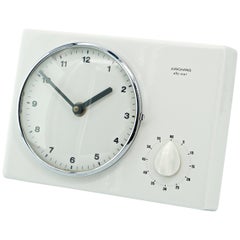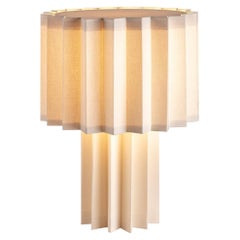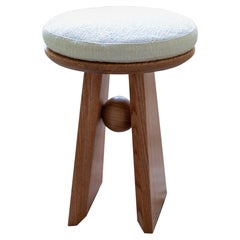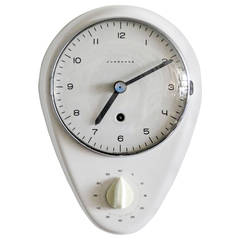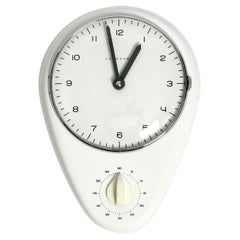Max Bill Wall Clock 1950
Vintage 1950s German Mid-Century Modern Wall Clocks
Porcelain
Vintage 1950s German Mid-Century Modern Wall Clocks
Brass
People Also Browsed
21st Century and Contemporary Swedish Mid-Century Modern Table Lamps
Textile
2010s Mexican Mid-Century Modern Stools
Hardwood
Vintage 1970s English Industrial Wall Clocks
Steel, Chrome
Vintage 1970s German Post-Modern Table Clocks and Desk Clocks
Plastic
Vintage 1950s German Mid-Century Modern Musical Instruments
Plastic, Wood
Vintage 1960s German Industrial Musical Instruments
Metal
Vintage 1970s Japanese Industrial Wall Clocks
Steel, Cut Steel
Vintage 1980s Japanese Industrial Wall Clocks
Steel, Cut Steel, Chrome
Vintage 1970s English Industrial Wall Clocks
Bronze, Steel, Chrome
Vintage 1930s German Art Deco Wall Clocks
Metal
Vintage 1960s German Mid-Century Modern Sofas
Leather
Vintage 1970s Japanese Industrial Wall Clocks
Steel, Cut Steel
Antique 1660s German Mid-Century Modern Credenzas
Aluminum
Vintage 1970s German Mid-Century Modern Wall Clocks
Brass
Vintage 1950s Japanese Mid-Century Modern Animal Sculptures
Metal
Vintage 1960s German Mid-Century Modern Sofa Tables
Fiberglass
Recent Sales
Vintage 1950s German Wall Clocks
Brass, Metal
Vintage 1950s German Mid-Century Modern Wall Clocks
Ceramic, Glass
Mid-20th Century Austrian Mid-Century Modern Clocks
Early 2000s Abstract Abstract Prints
Lithograph
Vintage 1950s German Mid-Century Modern Wall Clocks
Ceramic
Vintage 1950s German Mid-Century Modern Wall Clocks
Ceramic, Glass, Plastic
Vintage 1950s German Mid-Century Modern Wall Clocks
Metal
Vintage 1950s German Mid-Century Modern Wall Clocks
Porcelain
Vintage 1950s German Mid-Century Modern Wall Clocks
Metal
Max Bill for sale on 1stDibs
Max Bill was born in Winterthur, Switzerland. After an apprenticeship as a silversmith during 1924–27, he took up studies at the Bauhaus in Dessau under many teachers including Wassily Kandinsky, Paul Klee and Oskar Schlemmer from 1927 to 1929, after which he moved to Zurich.
After working on graphic designs for the few modern buildings being constructed, Bill built his first work, his own house and studio (1932–3) in Zurich-Höngg. From 1937 onward he was a prime mover behind the Allianz group of Swiss artists.
Bill is widely considered the single most decisive influence on Swiss graphic design beginning in the 1950s with his theoretical writing and progressive work. His connection to the days of modernism gave him special authority. As an industrial designer, his work is characterized by a clarity of design and precise proportions. Examples are the elegant clocks and watches designed for Junghans, a long-term client. Among Bill's most notable product designs is the Ulmer Hocker of 1954, a stool that can also be used as a shelf element, a speaker's desk, a tablet or a side table. Although the stool was a creation of both Bill's and Ulm School designer Hans Gugelot's, it is often called "Bill Hocker" because the first sketch of it on a cocktail napkin was Bill's work.
As a designer and artist, Bill sought to create forms which visually represent the New Physics of the early 20th century. He sought to create objects so that the new science of form could be understood by the senses: that is as a concrete art. Thus Bill is not a rationalist – as is typically thought – but rather a phenomenologist. He made spare geometric paintings, prints and spherical sculptures, some based on the Möbius strip, in stone, wood, metal and plaster. His architectural work included an office building in Germany, a radio studio in Zurich, and a bridge in eastern Switzerland.
Bill continued to produce architectural designs, such as those for a museum of contemporary art (1981) in Florence and for the Bauhaus Archive (1987) in Berlin. In 1982 he also entered a competition for an addition to the Neue Nationalgalerie in Berlin, built to a design by Ludwig Mies van der Rohe. Pavillon-Skulptur, a large granite sculpture, was installed adjacent to the Bahnhofstrasse, Zürich in 1983. As is often the case with modern art in public places, the installation generated some controversy. Endlose Treppe, a sculpture made of North American granite, was designed for the philosopher Ernst Bloch.
In 1982 he was awarded the Sir Misha Black award and was added to the College of Medallists.
Bill executed many public sculptures in Europe and exhibited extensively in galleries and museums, including a retrospective at the Kunsthaus Zürich in 1968–69. He was the subject of retrospectives at the Albright-Knox Art Gallery in Buffalo and the Los Angeles County Museum of Art in 1974, and the Solomon R. Guggenheim Museum in New York City in 1988.
Find vintage Max Bill stools, lighting, and other furniture on 1stDibs.
A Close Look at mid-century-modern Furniture
Organically shaped, clean-lined and elegantly simple are three terms that well describe vintage mid-century modern furniture. The style, which emerged primarily in the years following World War II, is characterized by pieces that were conceived and made in an energetic, optimistic spirit by creators who believed that good design was an essential part of good living.
ORIGINS OF MID-CENTURY MODERN FURNITURE DESIGN
- Emerged during the mid-20th century
- Informed by European modernism, Bauhaus, International style, Scandinavian modernism and Frank Lloyd Wright’s architecture
- A heyday of innovation in postwar America
- Experimentation with new ideas, new materials and new forms flourished in Scandinavia, Italy, the former Czechoslovakia and elsewhere in Europe
CHARACTERISTICS OF MID-CENTURY MODERN FURNITURE DESIGN
- Simplicity, organic forms, clean lines
- A blend of neutral and bold Pop art colors
- Use of natural and man-made materials — alluring woods such as teak, rosewood and oak; steel, fiberglass and molded plywood
- Light-filled spaces with colorful upholstery
- Glass walls and an emphasis on the outdoors
- Promotion of functionality
MID-CENTURY MODERN FURNITURE DESIGNERS TO KNOW
- Charles and Ray Eames
- Eero Saarinen
- Milo Baughman
- Florence Knoll
- Harry Bertoia
- Isamu Noguchi
- George Nelson
- Danish modernists Hans Wegner and Arne Jacobsen, whose emphasis on natural materials and craftsmanship influenced American designers and vice versa
ICONIC MID-CENTURY MODERN FURNITURE DESIGNS
- Eames lounge chair
- Nelson daybed
- Florence Knoll sofa
- Egg chair
- Womb chair
- Noguchi coffee table
- Barcelona chair
VINTAGE MID-CENTURY MODERN FURNITURE ON 1STDIBS
The mid-century modern era saw leagues of postwar American architects and designers animated by new ideas and new technology. The lean, functionalist International-style architecture of Le Corbusier and Bauhaus eminences Ludwig Mies van der Rohe and Walter Gropius had been promoted in the United States during the 1930s by Philip Johnson and others. New building techniques, such as “post-and-beam” construction, allowed the International-style schemes to be realized on a small scale in open-plan houses with long walls of glass.
Materials developed for wartime use became available for domestic goods and were incorporated into mid-century modern furniture designs. Charles and Ray Eames and Eero Saarinen, who had experimented extensively with molded plywood, eagerly embraced fiberglass for pieces such as the La Chaise and the Womb chair, respectively.
Architect, writer and designer George Nelson created with his team shades for the Bubble lamp using a new translucent polymer skin and, as design director at Herman Miller, recruited the Eameses, Alexander Girard and others for projects at the legendary Michigan furniture manufacturer.
Harry Bertoia and Isamu Noguchi devised chairs and tables built of wire mesh and wire struts. Materials were repurposed too: The Danish-born designer Jens Risom created a line of chairs using surplus parachute straps for webbed seats and backrests.
The Risom lounge chair was among the first pieces of furniture commissioned and produced by legendary manufacturer Knoll, a chief influencer in the rise of modern design in the United States, thanks to the work of Florence Knoll, the pioneering architect and designer who made the firm a leader in its field. The seating that Knoll created for office spaces — as well as pieces designed by Florence initially for commercial clients — soon became desirable for the home.
As the demand for casual, uncluttered furnishings grew, more mid-century furniture designers caught the spirit.
Classically oriented creators such as Edward Wormley, house designer for Dunbar Inc., offered such pieces as the sinuous Listen to Me chaise; the British expatriate T.H. Robsjohn-Gibbings switched gears, creating items such as the tiered, biomorphic Mesa table. There were Young Turks such as Paul McCobb, who designed holistic groups of sleek, blond wood furniture, and Milo Baughman, who espoused a West Coast aesthetic in minimalist teak dining tables and lushly upholstered chairs and sofas with angular steel frames.
As the collection of vintage mid-century modern chairs, dressers, coffee tables and other furniture for the living room, dining room, bedroom and elsewhere on 1stDibs demonstrates, this period saw one of the most delightful and dramatic flowerings of creativity in design history.
Finding the Right wall-clocks for You
Antique, new and vintage wall clocks have become available over the years in a diverse range of materials, such as wood, metal and glass, as well as styles from mid-century modern to Industrial.
Wall clocks have been designed by acclaimed creators and manufacturers such as Howard Miller Clock Company, Junghans Uhren GmbH, Pragotron and more. The Ball clock and Sunflower clock, which were created by designer Irving Harper in George Nelson’s studio during the mid-century era, are known to design enthusiasts and have become highly collectible over the years.
Whether you want an antique timepiece or one that will match a modern motif, you are sure to find one to suit any home or office decor.
The wall clocks of today have come a long way from the mechanical timepieces that originated in the 14th century. One of the most famous clocks from this era was made by Italian astronomer and physician Giovanni de’ Dondi and took approximately 16 years to complete. By the 17th century, wall clocks were popular luxury objects for the home.
Wall clock choices are not limited to just something that keeps time. A 19th-century bronze cartel clock and barometer set is an elegant addition to a foyer, while a vintage world-map clock allows you to see the time in several locations at once. Cleverly designed clocks have been created for all manner of tastes over the years.
On 1stDibs, you will find wall clocks and other types of antique and vintage clocks from various time periods, from Louis XV to Art Deco, and from all over the world, including Germany, France, the United Kingdom and elsewhere. Bring a touch of class and personality into your living room or dining room with a unique timepiece.
